Cultural elements and their potentials to develop students’ intercultural competence: a survey on english textbooks used in classes of language skills at university of foreign languages, Hue university
Abstract: Intercultural competence is one of the most fundamental components that should
be developed among language users and can be attained in many different ways. Several
studies have suggested that cultural elements incorporated in English textbooks can be of
great significance in helping learners acquired intercultural competence. This paper
presents the results of a survey on English textbooks used for teaching language skills at the
Department of English and the Department of International Studies, Hue University of
Foreign Languages. The findings reveal an inclusion of several usable cultural elements
from both the inner circle and outer circle cultures in such textbooks; however, most of
them reflect surface cultural values rather than deep cultural ones. Besides, although deep
culture elements are incorporated, these are addressed at a pretty shallow level. It is
suggested that in order to enhance students’ intercultural competence, teachers and students
need further effort to take full advantage of the available cultural elements. This paper also
gives recommendation on effective use of such elements.
Key words: Deep cultural values, intercultural competence, surface cultural values
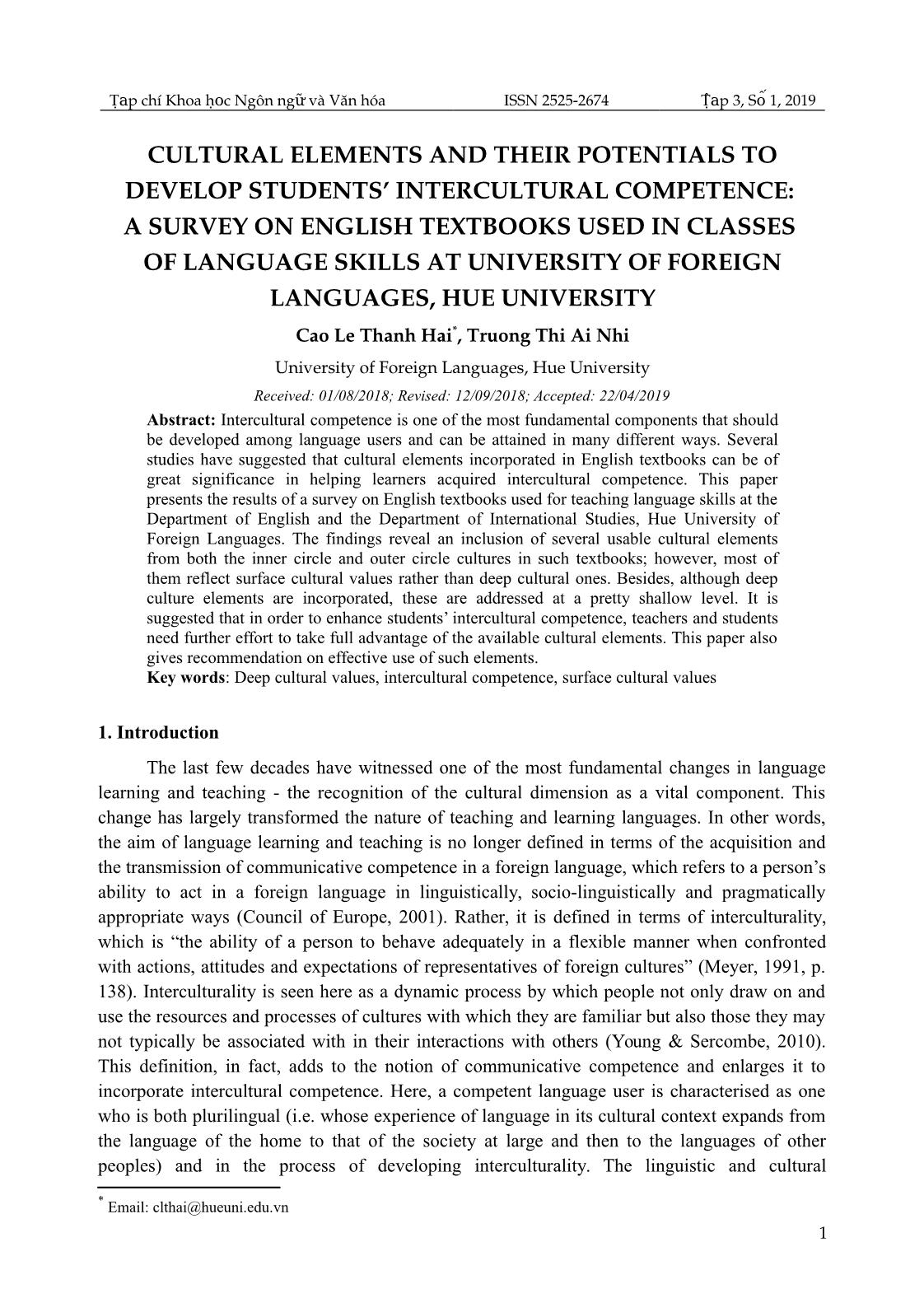
Trang 1

Trang 2
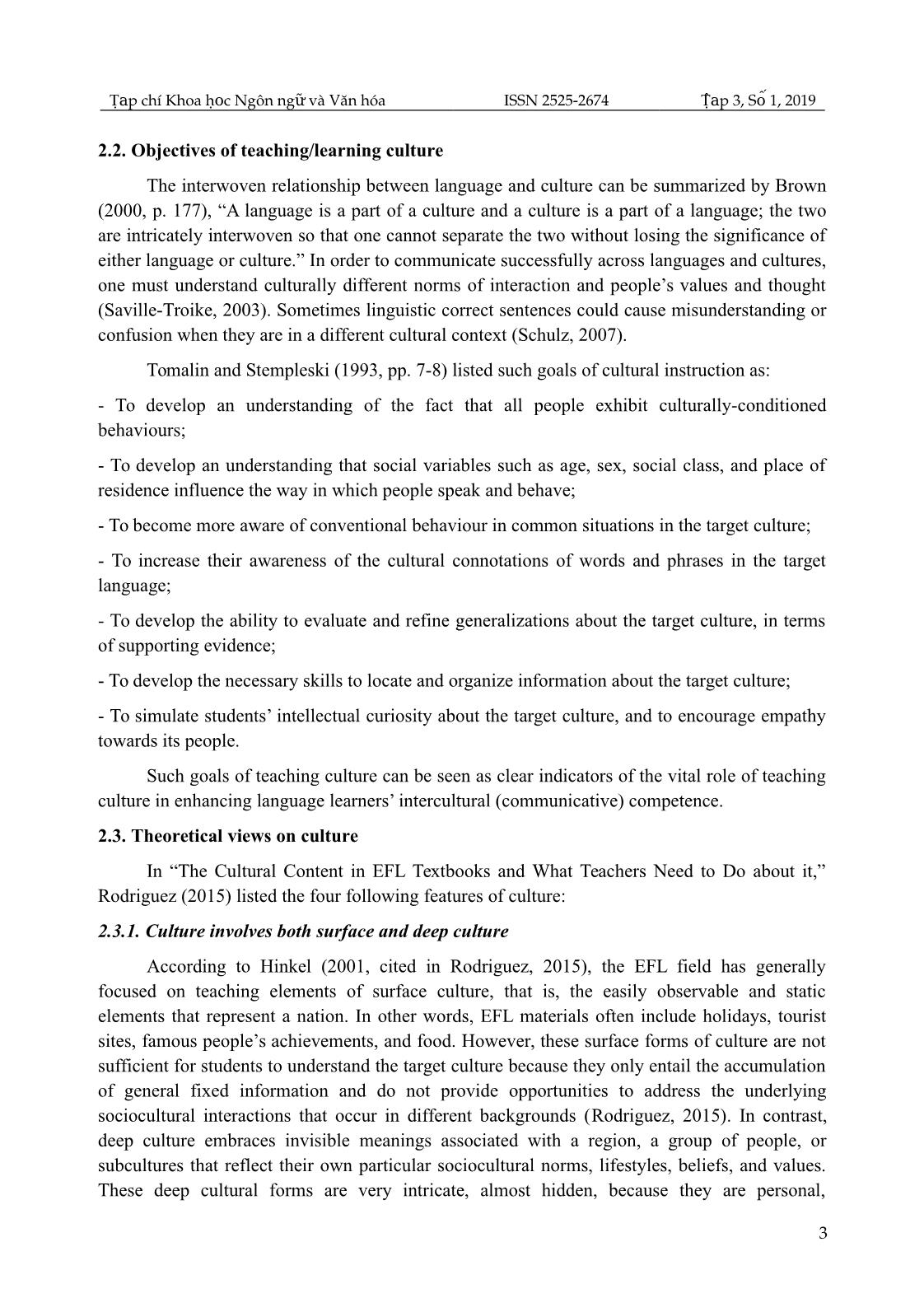
Trang 3

Trang 4
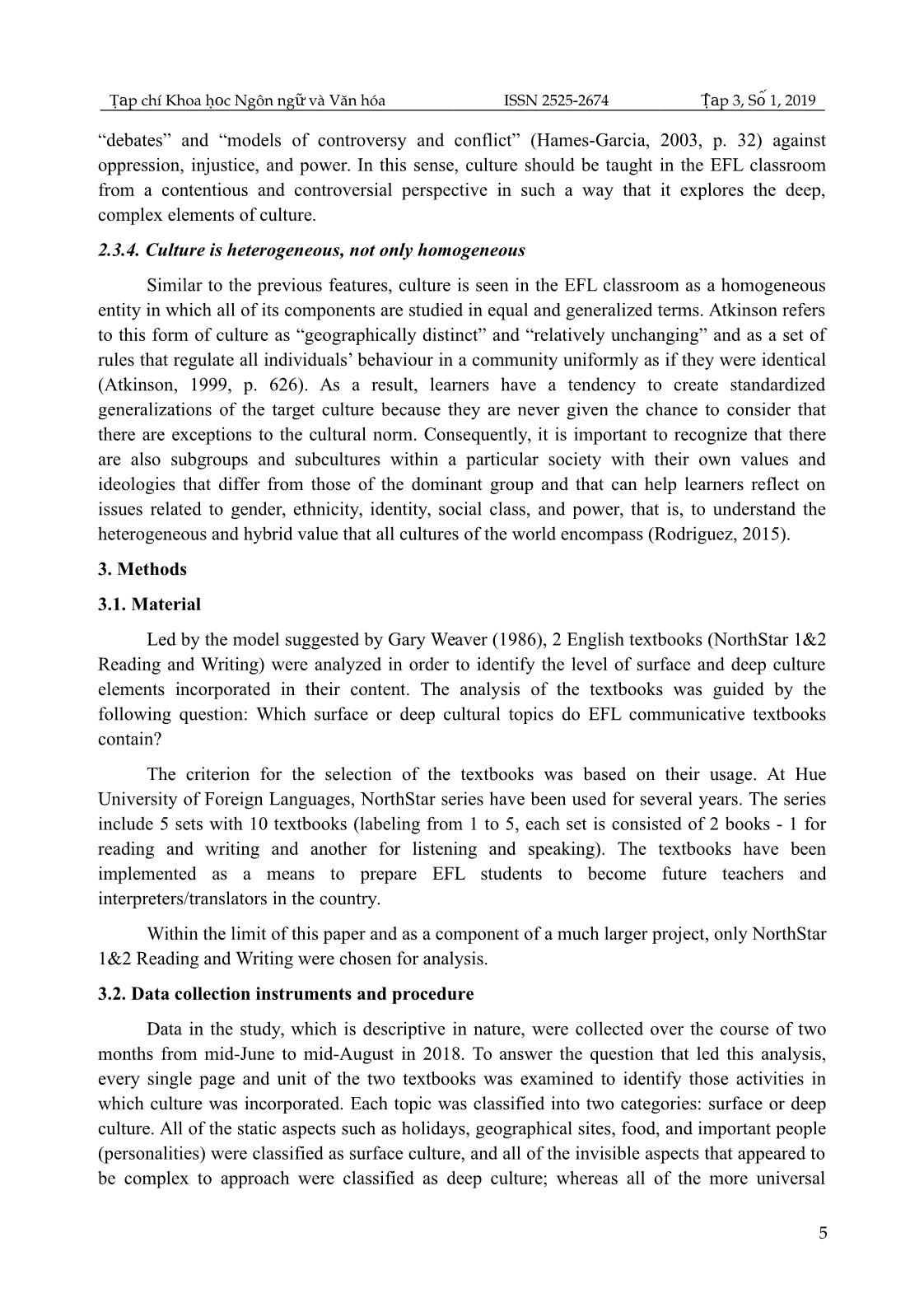
Trang 5
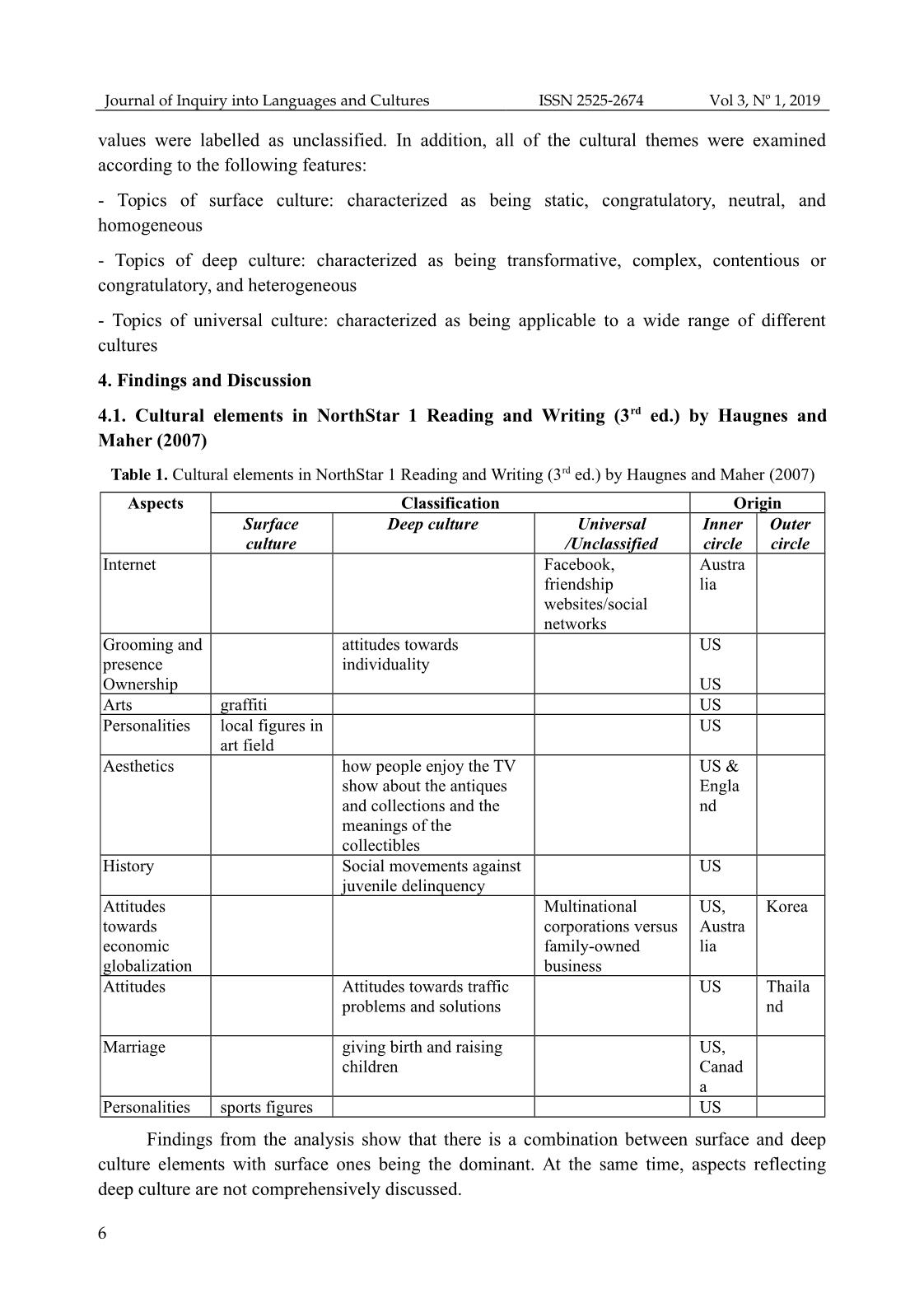
Trang 6
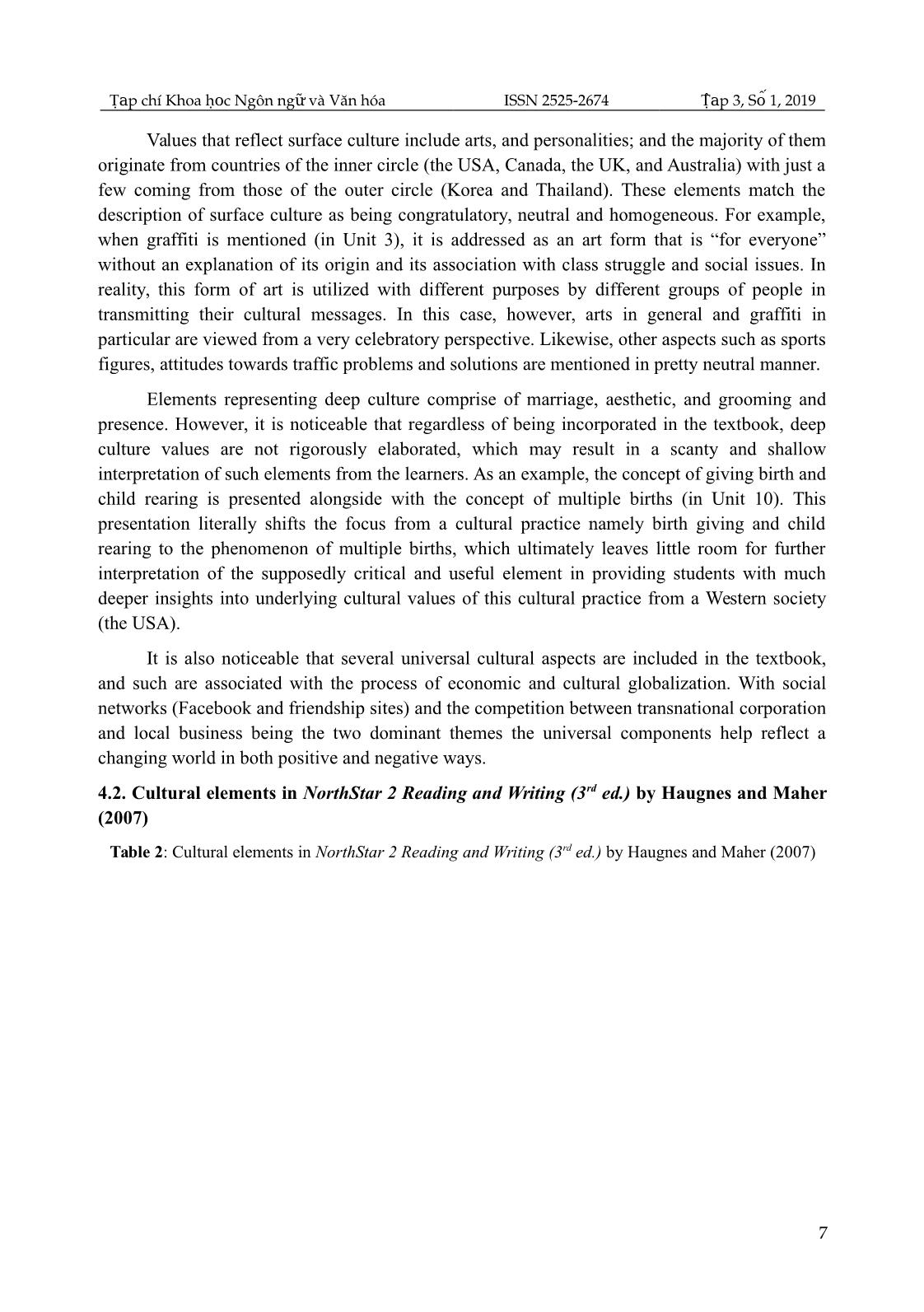
Trang 7
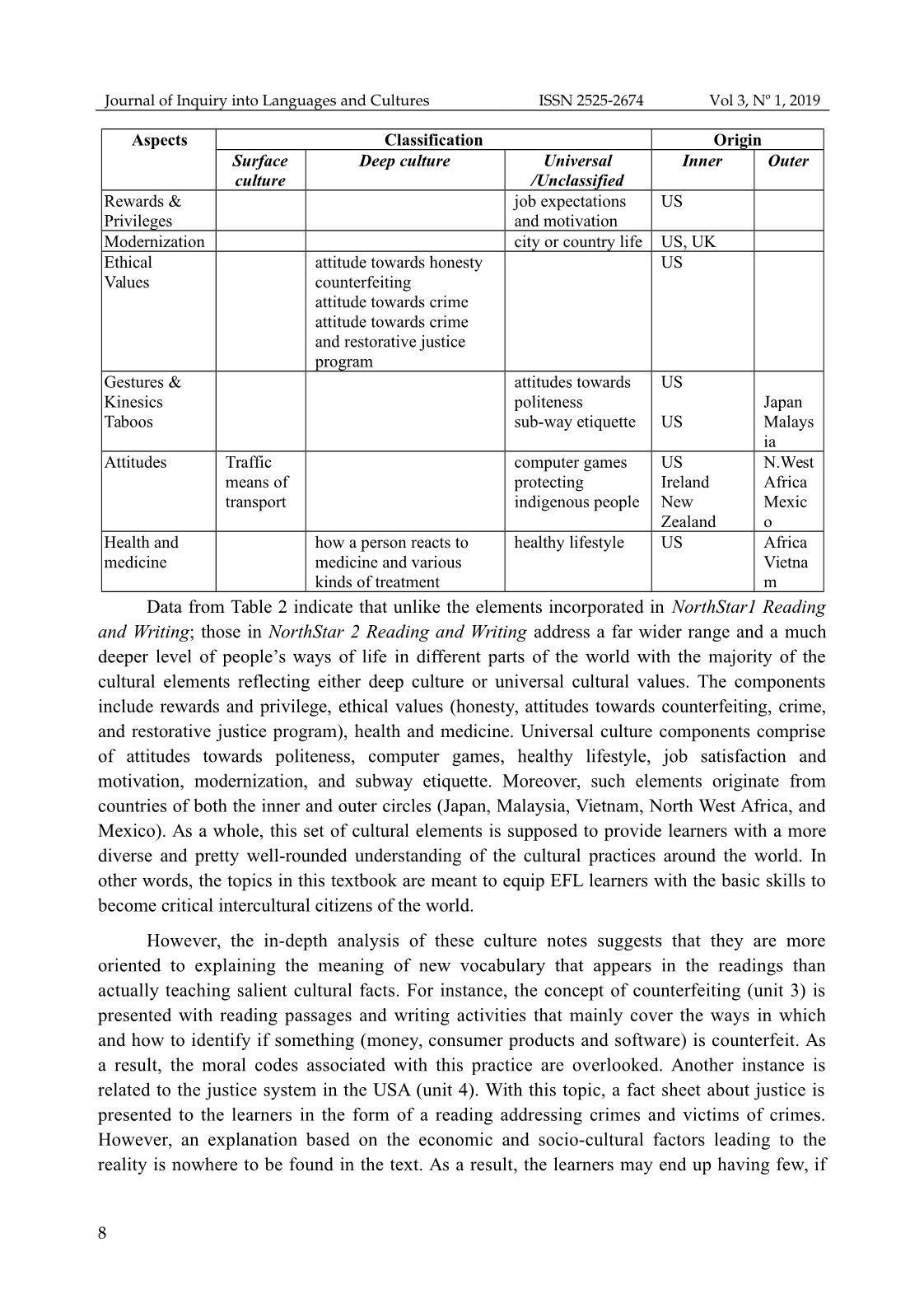
Trang 8

Trang 9
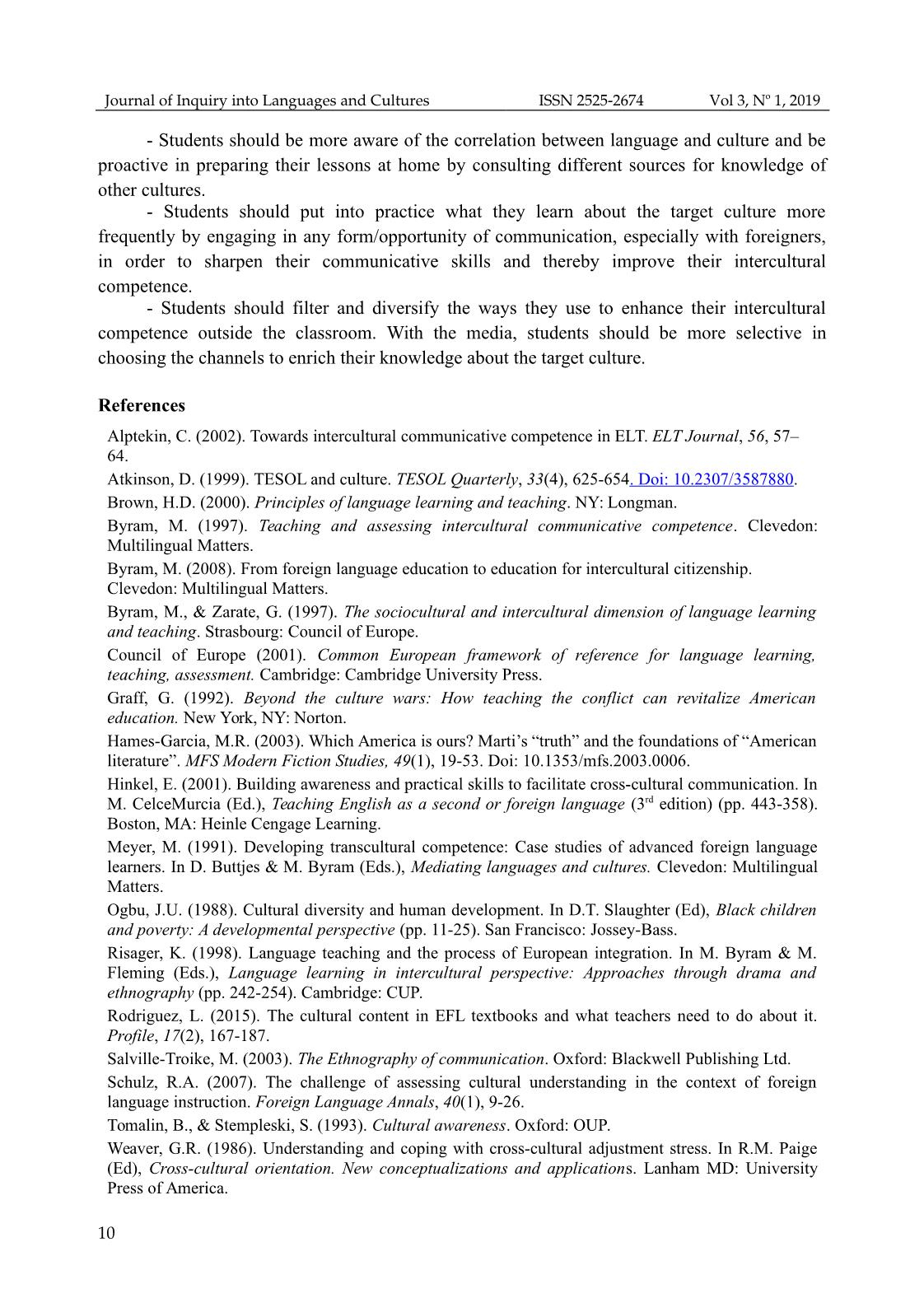
Trang 10
Tải về để xem bản đầy đủ
Tóm tắt nội dung tài liệu: Cultural elements and their potentials to develop students’ intercultural competence: a survey on english textbooks used in classes of language skills at university of foreign languages, Hue university
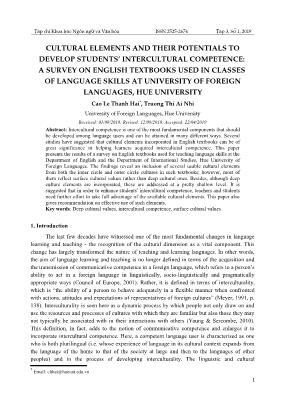
T p chí Khoa h c Ngôn ng và Văn hóaạ ọ ữ ISSN 25252674 T p 3, S 1, 2019ậ ố CULTURAL ELEMENTS AND THEIR POTENTIALS TO DEVELOP STUDENTS’ INTERCULTURAL COMPETENCE: A SURVEY ON ENGLISH TEXTBOOKS USED IN CLASSES OF LANGUAGE SKILLS AT UNIVERSITY OF FOREIGN LANGUAGES, HUE UNIVERSITY Cao Le Thanh Hai*, Truong Thi Ai Nhi University of Foreign Languages, Hue University Received: 01/08/2018; Revised: 12/09/2018; Accepted: 22/04/2019 Abstract: Intercultural competence is one of the most fundamental components that should be developed among language users and can be attained in many different ways. Several studies have suggested that cultural elements incorporated in English textbooks can be of great significance in helping learners acquired intercultural competence. This paper presents the results of a survey on English textbooks used for teaching language skills at the Department of English and the Department of International Studies, Hue University of Foreign Languages. The findings reveal an inclusion of several usable cultural elements from both the inner circle and outer circle cultures in such textbooks; however, most of them reflect surface cultural values rather than deep cultural ones. Besides, although deep culture elements are incorporated, these are addressed at a pretty shallow level. It is suggested that in order to enhance students’ intercultural competence, teachers and students need further effort to take full advantage of the available cultural elements. This paper also gives recommendation on effective use of such elements. Key words: Deep cultural values, intercultural competence, surface cultural values 1. Introduction The last few decades have witnessed one of the most fundamental changes in language learning and teaching - the recognition of the cultural dimension as a vital component. This change has largely transformed the nature of teaching and learning languages. In other words, the aim of language learning and teaching is no longer defined in terms of the acquisition and the transmission of communicative competence in a foreign language, which refers to a person’s ability to act in a foreign language in linguistically, socio-linguistically and pragmatically appropriate ways (Council of Europe, 2001). Rather, it is defined in terms of interculturality, which is “the ability of a person to behave adequately in a flexible manner when confronted with actions, attitudes and expectations of representatives of foreign cultures” (Meyer, 1991, p. 138). Interculturality is seen here as a dynamic process by which people not only draw on and use the resources and processes of cultures with which they are familiar but also those they may not typically be associated with in their interactions with others (Young & Sercombe, 2010). This definition, in fact, adds to the notion of communicative competence and enlarges it to incorporate intercultural competence. Here, a competent language user is characterised as one who is both plurilingual (i.e. whose experience of language in its cultural context expands from the language of the home to that of the society at large and then to the languages of other peoples) and in the process of developing interculturality. The linguistic and cultural * Email: clthai@hueuni.edu.vn 1 Journal of Inquiry into Languages and Cultures ISSN 25252674 Vol 3, No 1, 2019 competences in respect of each language used by the learner are modified by knowledge of the other and contribute towards intercultural awareness, skills, and know-how. An important motivation for the advocacy of interculturality are perceptions that intercultural contact and interchange are greater than ever, necessitating approaches to understanding and brokering difference through effective communication. From this position, language learning is the best place within the educational field for the learning of and about culture, reflecting powerful interrelationships between language and culture (Risager, 1998). At the Department of English and the Department of International Studies, Hue University of Foreign Languages, in order to help students develop their intercultural competence, courses in British and American culture have been added to the curriculum since the very beginning. Despite intermittent changes in the textbooks used, these courses have consistently covered a wide range of topics that were listed by CEF (2001) as seven categories that are considered characteristic of a particular European society and its culture which include everyday living, living condition, interpersonal relations, values, beliefs and attitudes, body language, social conventions and ritual behaviours. While the use of culture as a way to enhance students’ intercultural competence has been highly recognized and sought after by teachers and curriculum designers from the department; the effort, in the researcher’s opinion, should be more rigorous. In other words, c ... and Writing (3rd ed.) by Haugnes and Maher (2007) Aspects Classification Origin Surface culture Deep culture Universal /Unclassified Inner circle Outer circle Internet Facebook, friendship websites/social networks Austra lia Grooming and presence Ownership attitudes towards individuality US US Arts graffiti US Personalities local figures in art field US Aesthetics how people enjoy the TV show about the antiques and collections and the meanings of the collectibles US & Engla nd History Social movements against juvenile delinquency US Attitudes towards economic globalization Multinational corporations versus family-owned business US, Austra lia Korea Attitudes Attitudes towards traffic problems and solutions US Thaila nd Marriage giving birth and raising children US, Canad a Personalities sports figures US Findings from the analysis show that there is a combination between surface and deep culture elements with surface ones being the dominant. At the same time, aspects reflecting deep culture are not comprehensively discussed. 6 T p chí Khoa h c Ngôn ng và Văn hóaạ ọ ữ ISSN 25252674 T p 3, S 1, 2019ậ ố Values that reflect surface culture include arts, and personalities; and the majority of them originate from countries of the inner circle (the USA, Canada, the UK, and Australia) with just a few coming from those of the outer circle (Korea and Thailand). These elements match the description of surface culture as being congratulatory, neutral and homogeneous. For example, when graffiti is mentioned (in Unit 3), it is addressed as an art form that is “for everyone” without an explanation of its origin and its association with class struggle and social issues. In reality, this form of art is utilized with different purposes by different groups of people in transmitting their cultural messages. In this case, however, arts in general and graffiti in particular are viewed from a very celebratory perspective. Likewise, other aspects such as sports figures, attitudes towards traffic problems and solutions are mentioned in pretty neutral manner. Elements representing deep culture comprise of marriage, aesthetic, and grooming and presence. However, it is noticeable that regardless of being incorporated in the textbook, deep culture values are not rigorously elaborated, which may result in a scanty and shallow interpretation of such elements from the learners. As an example, the concept of giving birth and child rearing is presented alongside with the concept of multiple births (in Unit 10). This presentation literally shifts the focus from a cultural practice namely birth giving and child rearing to the phenomenon of multiple births, which ultimately leaves little room for further interpretation of the supposedly critical and useful element in providing students with much deeper insights into underlying cultural values of this cultural practice from a Western society (the USA). It is also noticeable that several universal cultural aspects are included in the textbook, and such are associated with the process of economic and cultural globalization. With social networks (Facebook and friendship sites) and the competition between transnational corporation and local business being the two dominant themes the universal components help reflect a changing world in both positive and negative ways. 4.2. Cultural elements in NorthStar 2 Reading and Writing (3rd ed.) by Haugnes and Maher (2007) Table 2: Cultural elements in NorthStar 2 Reading and Writing (3rd ed.) by Haugnes and Maher (2007) 7 Journal of Inquiry into Languages and Cultures ISSN 25252674 Vol 3, No 1, 2019 Data from Table 2 indicate that unlike the elements incorporated in NorthStar1 Reading and Writing; those in NorthStar 2 Reading and Writing address a far wider range and a much deeper level of people’s ways of life in different parts of the world with the majority of the cultural elements reflecting either deep culture or universal cultural values. The components include rewards and privilege, ethical values (honesty, attitudes towards counterfeiting, crime, and restorative justice program), health and medicine. Universal culture components comprise of attitudes towards politeness, computer games, healthy lifestyle, job satisfaction and motivation, modernization, and subway etiquette. Moreover, such elements originate from countries of both the inner and outer circles (Japan, Malaysia, Vietnam, North West Africa, and Mexico). As a whole, this set of cultural elements is supposed to provide learners with a more diverse and pretty well-rounded understanding of the cultural practices around the world. In other words, the topics in this textbook are meant to equip EFL learners with the basic skills to become critical intercultural citizens of the world. However, the in-depth analysis of these culture notes suggests that they are more oriented to explaining the meaning of new vocabulary that appears in the readings than actually teaching salient cultural facts. For instance, the concept of counterfeiting (unit 3) is presented with reading passages and writing activities that mainly cover the ways in which and how to identify if something (money, consumer products and software) is counterfeit. As a result, the moral codes associated with this practice are overlooked. Another instance is related to the justice system in the USA (unit 4). With this topic, a fact sheet about justice is presented to the learners in the form of a reading addressing crimes and victims of crimes. However, an explanation based on the economic and socio-cultural factors leading to the reality is nowhere to be found in the text. As a result, the learners may end up having few, if 8 Aspects Classification Origin Surface culture Deep culture Universal /Unclassified Inner Outer Rewards & Privileges job expectations and motivation US Modernization city or country life US, UK Ethical Values attitude towards honesty counterfeiting attitude towards crime attitude towards crime and restorative justice program US Gestures & Kinesics Taboos attitudes towards politeness sub-way etiquette US US Japan Malays ia Attitudes Traffic means of transport computer games protecting indigenous people US Ireland New Zealand N.West Africa Mexic o Health and medicine how a person reacts to medicine and various kinds of treatment healthy lifestyle US Africa Vietna m T p chí Khoa h c Ngôn ng và Văn hóaạ ọ ữ ISSN 25252674 T p 3, S 1, 2019ậ ố any, clues about the roots of the problem which are race, class and gender discrimination and the flaws in the US social structure. 5. Conclusion and implications The findings reveal an inclusion of several usable cultural elements from both the inner circle and outer circle cultures in such textbooks; however, most of them reflect surface cultural values rather than deep cultural ones. Besides, although deep culture elements are incorporated, these are addressed at a pretty superficial level, which does not yield much interpretation of the underlying economic, socio-cultural factors that form such elements. Furthermore, there is a lack of even representativeness from different cultures/regions across the globe. As a result, learners are not likely to be equipped with a comprehensive understanding of the target cultures and other cultures across the world, which definitely pose a lot of obstacles to students’ enhancement of their intercultural communication competence. Given the focus of these textbooks is on honing and perfecting students’ language skills, the manner in which such cultural elements are incorporated can partly be justified. Nevertheless, that does not necessarily mean that teachers and learners should stay inactive in their usage of the textbooks in general and of the cultural aspects in particular. In contrast, they need to make further efforts to take full advantage of the available cultural elements. More specifically, cooperation from both teachers and learners before, during and after each class should be sought after in order to tackle the available cultural elements from a multi-faceted perspective, and thereby enhancing students’ intercultural communication competence. In order to fully take advantage of the cultural elements incorporated in the textbooks, recommendations to help teachers and students develop and enhance intercultural competence through English-skill practice classes are suggested as followed: - Teaching culture through language skills development can be both challenging and interesting. It is challenging because this is not the main focus of the reading and writing classes. However, it will be useful for teachers to integrate cultural teaching into their lessons so that the reading and writing assignment can become more vivid and be completed in a more effective way, which ultimately results in students’ improvement of their intercultural communication competence. - For more effective classes, teachers can request students to prepare some aspects on cultures around the world that are related to the relevant topic(s) of each lesson. Students can then be required to present those cultural elements to the whole class as a warm-up activity. This way, students can be more engaged in the classroom, and more importantly, they are well- informed of both surface and deep culture. - Teachers of such classes should keep themselves constantly updated with newly added cultural values to be able to facilitate learners in their intercultural communicative competence (ICC) attainment process. - Teachers should also raise students’ awareness about the importance of accumulating knowledge of different cultures as this is essential for students majoring in foreign languages. 9 Journal of Inquiry into Languages and Cultures ISSN 25252674 Vol 3, No 1, 2019 - Students should be more aware of the correlation between language and culture and be proactive in preparing their lessons at home by consulting different sources for knowledge of other cultures. - Students should put into practice what they learn about the target culture more frequently by engaging in any form/opportunity of communication, especially with foreigners, in order to sharpen their communicative skills and thereby improve their intercultural competence. - Students should filter and diversify the ways they use to enhance their intercultural competence outside the classroom. With the media, students should be more selective in choosing the channels to enrich their knowledge about the target culture. References Alptekin, C. (2002). Towards intercultural communicative competence in ELT. ELT Journal, 56, 57– 64. Atkinson, D. (1999). TESOL and culture. TESOL Quarterly, 33(4), 625-654. Doi: 10.2307/3587880. Brown, H.D. (2000). Principles of language learning and teaching. NY: Longman. Byram, M. (1997). Teaching and assessing intercultural communicative competence. Clevedon: Multilingual Matters. Byram, M. (2008). From foreign language education to education for intercultural citizenship. Clevedon: Multilingual Matters. Byram, M., & Zarate, G. (1997). The sociocultural and intercultural dimension of language learning and teaching. Strasbourg: Council of Europe. Council of Europe (2001). Common European framework of reference for language learning, teaching, assessment. Cambridge: Cambridge University Press. Graff, G. (1992). Beyond the culture wars: How teaching the conflict can revitalize American education. New York, NY: Norton. Hames-Garcia, M.R. (2003). Which America is ours? Marti’s “truth” and the foundations of “American literature”. MFS Modern Fiction Studies, 49(1), 19-53. Doi: 10.1353/mfs.2003.0006. Hinkel, E. (2001). Building awareness and practical skills to facilitate cross-cultural communication. In M. CelceMurcia (Ed.), Teaching English as a second or foreign language (3rd edition) (pp. 443-358). Boston, MA: Heinle Cengage Learning. Meyer, M. (1991). Developing transcultural competence: Case studies of advanced foreign language learners. In D. Buttjes & M. Byram (Eds.), Mediating languages and cultures. Clevedon: Multilingual Matters. Ogbu, J.U. (1988). Cultural diversity and human development. In D.T. Slaughter (Ed), Black children and poverty: A developmental perspective (pp. 11-25). San Francisco: Jossey-Bass. Risager, K. (1998). Language teaching and the process of European integration. In M. Byram & M. Fleming (Eds.), Language learning in intercultural perspective: Approaches through drama and ethnography (pp. 242-254). Cambridge: CUP. Rodriguez, L. (2015). The cultural content in EFL textbooks and what teachers need to do about it. Profile, 17(2), 167-187. Salville-Troike, M. (2003). The Ethnography of communication. Oxford: Blackwell Publishing Ltd. Schulz, R.A. (2007). The challenge of assessing cultural understanding in the context of foreign language instruction. Foreign Language Annals, 40(1), 9-26. Tomalin, B., & Stempleski, S. (1993). Cultural awareness. Oxford: OUP. Weaver, G.R. (1986). Understanding and coping with cross-cultural adjustment stress. In R.M. Paige (Ed), Cross-cultural orientation. New conceptualizations and applications. Lanham MD: University Press of America. 10 T p chí Khoa h c Ngôn ng và Văn hóaạ ọ ữ ISSN 25252674 T p 3, S 1, 2019ậ ố Young, T.J., & Sercombe, P. (2010). Communication, discourses and interculturality. Language and Intercultural Communication, 10, 181-188. Y U T VĂN HÓA VÀ TI M NĂNG TRONG VI C PHÁT TRI NẾ Ố Ề Ệ Ể NĂNG L C LIÊN VĂN HÓA CHO SINH VIÊN: KH O SÁT Ự Ả GIÁO TRÌNH Đ C S D NG TRONG CÁC L P TH C HÀNHƯỢ Ử Ụ Ớ Ự TI NG T I TR NG Đ I H C NGO I NG , Đ I H C HUẾ Ạ ƯỜ Ạ Ọ Ạ Ữ Ạ Ọ Ế Tóm tắt: Năng lực liên văn hóa là một trong những thành tố cần được phát triển ở người sử dụng ngoại ngữ. Nhiều nghiên cứu chỉ ra rằng các yếu tố văn hóa trong giáo trình tiếng Anh có ý nghĩa quan trọng trong việc giúp người học lĩnh hội năng lực này. Bài báo trình bày kết quả khảo sát giáo trình thực hành tiếng tại khoa Tiếng Anh, Trường Đại học Ngoại ngữ, Đại học Huế. Kết quả khảo sát cho thấy các giáo trình được sử dụng có nhiều yếu tố văn hóa từ các nước sử dụng tiếng Anh như tiếng mẹ đẻ và những nước khác. Tuy nhiên, các yếu tố này chủ yếu phản ánh văn hóa bề mặt (surface culture), và việc đề cập các yếu tố văn hóa mang chiều sâu (deep culture) tương đối sơ sài. Vì vậy có thể kết luận rằng giáo viên và sinh viên cần nỗ lực nhiều hơn nhằm khai thác được tiềm năng của các yếu tố văn hóa này. Nghiên cứu cũng đưa ra những kiến nghị nhằm nâng cao hiệu quả việc sử dụng các giáo trình trong việc nâng cao năng lực liên văn hóa của sinh viên. Từ khóa: Giá trị văn hóa chiều sâu, năng lực liên văn hóa, giá trị văn hóa bề mặt 11
File đính kèm:
 cultural_elements_and_their_potentials_to_develop_students_i.pdf
cultural_elements_and_their_potentials_to_develop_students_i.pdf

